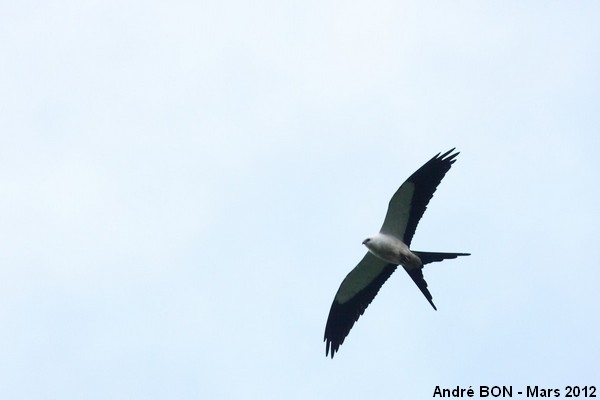
| Swallow-tailed Kite (Elanoides forficatus (Linnaeus, 1758)) |

|
|
Scientific name: Elanoides forficatus (Linnaeus, 1758) Common name: Swallow-tailed Kite Other names: Old scientific name: Falco forficatus. French name: Milan à queue fourchue Order: Accipitriformes Family: Accipitridae Size: Body size: 50 to 68 cm; Weight: 370 to 600 g; Wingspan: 112 to 136 cm. Habitat: Various habitats with high trees, forests and damp woodlands, next to open areas. Food: The Swallow-tailed Kite almost exclusively feeds on insects caught in flight. It may also eat chicks grasped on a branch or tree lizards. It drinks in flight, skimming the surface of the water. Nesting: The nest is generally built by the two members of the pair, near the top of a high tree. They are sometimes helped by non-breeder adults. The brood is made of 1 to 3 eggs. Migration: Sedentary in South America. Most of the birds nesting in North America and in Central America move to South America in winter. Geographic area: The Americas, from south-eastern regions of the United States to northern Argentina. |
As indicated by its common name the Swallow-tailed Kite shows a long and forked tail which is visible in flight and also when it is perched. Males and females are similar. The head, the neck and the under side of the body are white. The upper side is greyish and may show shades of blue, green or purple. The wing flight-feathers and tail-feathers are black. |
| [To know more about the Swallow-tailed Kite] [Top] |

|
The arrival of the daily flight makes a little animation in the village of Saül in the middle of the rainforest. We have been very kindly welcome by the inhabitants and by one Swallow-tailed Kite nicely flying around the church and the municipal house. By courtesy, I have not pulled out my camera from my bag for the occasion. The other observations of this beautiful bird have been done more in the far, and this picture, shot in the village, is an important crop. |